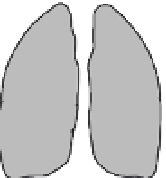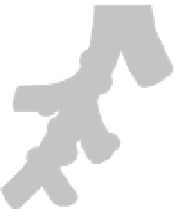Biomedical Engineering Reference
In-Depth Information
3.4.2 Respiratory System
The respiratory system (Figure 3.24a) moves air to and from the gas exchange surfaces in
the body where diffusion can occur between air and the circulating blood. It includes the
conduction zone and the respiratory zone. In the conduction zone (mouth, nose, sinuses,
pharynx, trachea, bronchi, and bronchioles), the air that enters the body is warmed, humidi-
fied, filtered, and cleaned. Mucus is secreted by cells in the conduction zone and traps small
particles (
m) before they can reach the respiratory zone. Epithelial cells that line the
trachea and bronchi have cilia that beat in a coordinated fashion to move mucus toward
the pharynx, where it can be swallowed or expectorated. The respiratory zone, consisting
of respiratory bronchioles with outpouchings of alveoli and terminal clusters of alveolar sacs,
is where gas exchange between air and blood occurs (Figure 3.24b). The respiratory zone
comprises most of the mass of the lungs.
Conduction of air begins at the larynx, or voice box, at the entrance to the trachea, which
is a fibromuscular tube 10 to 12 cm in length and 1.4 to 2.0 cm in diameter. At a location
called the
>
6
m
, the trachea terminates and divides in the left and right bronchi. Each
bronchus has a discontinuous cartilaginous support in its wall. Muscle fibers capable of
controlling airway diameter are incorporated into the walls of the bronchi, as well as in
those of air passages closer to the alveoli. Smooth muscle is present throughout the respira-
tory bronchiolus and alveolar ducts but is absent in the last alveolar duct, which terminates
in one to several alveoli. The alveolar walls are shared by other alveoli and are composed
of highly pliable and collapsible squamous epithelium cells. The bronchi subdivide into
subbronchi, which further subdivide into bronchioli, which further subdivide, and so on,
until finally reaching the alveolar level.
Movement of gases in the respiratory airways occurs mainly by bulk flow (convection)
throughout the region from the mouth to the nose to the fifteenth generation. Beyond the
carina
TERMINAL
BRONCHIOLE
NASAL
CAVITY
PHARYNX
LARYNX
ORAL
CAVITY
TRACHEA
LEFT
LUNG
ALVEOLUS
ALVEOLAR
DUCT
RIGHT
LUNG
ALVEOLAR
SAC
BRONCHIOLES
(a)
FIGURE 3.24
(a) The respiratory system consists of the passageways that are used to move air into and out of
the body and the lungs. (b) The terminal bronchioles and alveolar sacs within the lungs have alveoli where gas
exchange occurs between the lungs and the blood in the surrounding capillaries.
(b)












































































































































































































































































































































